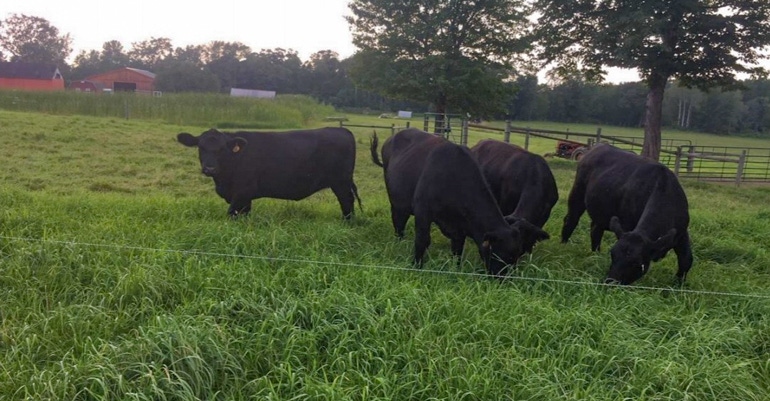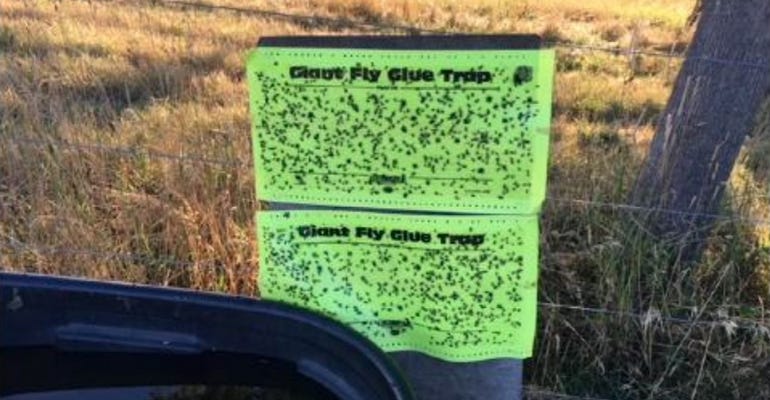April 2, 2019

By Deborah Jeanne Sergeant
Face flies. Every beef herd has them, but no one wants them. In addition to making life miserable for cattle, they can also cost producers money.
Fred Forsburg, owner of Honeyhill Farm in Livonia, N.Y., estimates that face flies cost him anywhere from $75 to $200 per animal because they can reduce weight gain in his cattle. To battle these pests, Forsburg believes it’s vital to “know your enemy.”
"Face flies are exclusively pasture flies not found in feedlots," he said in a recent webinar, “A New Approach to Managing Face Flies on Pasture Cattle,” put on by Food Animal Concerns Trust. "They lay eggs in undisturbed manure pats. They actually prefer grass-fed cattle."
The face fly problem is real on cattle operations. An online poll of webinar attendees showed 83% reported problems with face flies on their farm or with their cattle.
Forsburg intensively grazes 16 head of Angus on 50 acres, which includes 38 acres of native perennial pasture, silvopasture and woods. It's all fenced in to provide a variety of grazing options. The herd is on pasture the entire time and their meat is sold organic, so using sprays isn't an option.
Since he moves his cattle frequently, Forsburg said a stationary fly killer, such as an electric zapper, won't work well. Unlike dairy cows and horses, which you can outfit with fly masks, beef cattle resist such measures, he said.
Painful pests
Unlike mosquitoes that suck blood, face flies use "rasping mouth parts that annoy the sensitive members: the eyes, nose, muzzle and mouth," he said.
This can cause tissue damage and make cattle prone to other ailments such as bovine pinkeye, which can be costly for the farmer.
By late July or August, face flies are everywhere.
"Controls are different because where they feed is very sensitive organs," he said.
Even conventional producers can't use chemicals in these sensitive areas.
Forsburg said face flies are harder to control than horn flies.
"Cattle spend so much time and energy obtaining relief rather than grazing and ruminating," he said.
This can add up to a 12% to 15% reduction in weight gain.
It takes only two to three weeks for face fly eggs to hatch and mature, so a small face fly problem can quickly become a big one.
Finding a solution
When he started looking for a solution to his face fly problem in 2015, he couldn't find anything to help. For one thing, researchers still don't know how face flies find their hosts. While carbon dioxide signals mosquitoes to the presence of a host, Forsburg said there's no evidence of how face flies find cattle.
He stumbled on his face fly solution through a serendipitous moment. While cleaning up junk that the previous owner had left on the farm, he found a sheet of steel. While taking it to the barn, he noticed his herd's water tank was low. He placed the sheet against a fencepost near the water trough and started filling the trough. The herd came to get a drink. As the animals lowered their heads to drink the water, they disturbed the flies on their faces. The flies flew away and gathered on the sheet of steel, the nearest flat surface.
This gave Forsburg an idea: What if he could just trap the flies at the watering trough, a place his herd visits several times a day? To test his theory, he placed fly ribbons on a wood board between the trough and some wire.
"I caught hundreds in a couple minutes," he said.
He found large sheets of fly paper at Tractor Supply Co. and affixed them to a sheet of plywood with duct tape.
"I was absolutely surprised at how easy it was," he said. "Thousands of flies were caught in an afternoon."
 STICKY SOLUTION: Forsburg has found that placing fly glue traps near the watering trough will attract the face flies.
STICKY SOLUTION: Forsburg has found that placing fly glue traps near the watering trough will attract the face flies.

While using fly paper on a farm is nothing new, placing it in a strategic location near the watering trough made sense.
At first, Forsburg had to replace his fly sheets daily until he disrupted the fly life cycle and diminished their numbers. A retired entomologist from the University of Minnesota volunteered to look over his fly sheets and determined that half the flies were female.
"For every female fly you kill, you kill thousands of her progeny," Forsburg said.
The sheets last about three days. It costs him about 25 cents a day to bring his herd relief from face flies.
Sergeant writes from central New York.
You May Also Like




